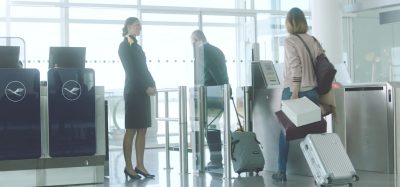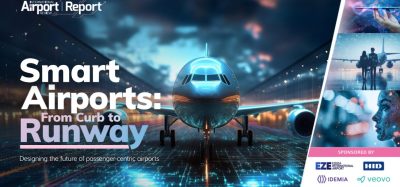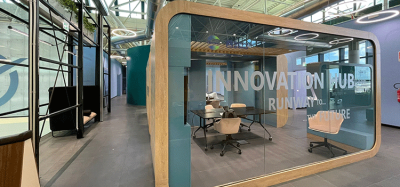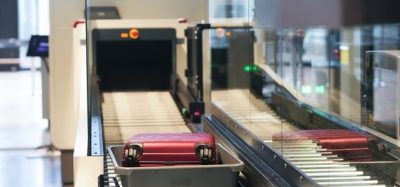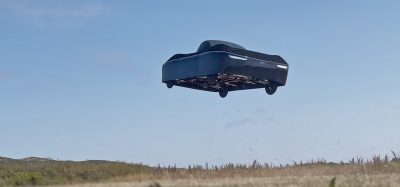Field testing the future at San Diego’s Airport Innovation Lab
Posted: 20 December 2019 | Rick Belliotti | Director of Innovation | San Diego | No comments yet
Rick Belliotti, San Diego County Regional Airport Authority’s Director of Customer Experience and Innovation, looks at the lessons learned, and innovations discovered, at San Diego’s Airport Innovation Lab.


Can airports innovate methods to improve the passenger experience, enhance efficiency, save money and generate new non-aeronautical revenues? The San Diego County Regional Airport Authority, owner and operator of San Diego International Airport (SAN), believes that with innovation, the answer is yes.
Nearly three years after its unveiling in a decommissioned terminal building, SAN’s Innovation Lab is working with its third group of innovators, ‘field testing’ new ideas in an airport environment without having to work around security, passengers and other complications.
Creating the Innovation Lab
After the former Commuter Terminal was decommissioned, we saw an opportunity to take part of the space and create a real-life testing ground for airport innovations with a working ticket counter, baggage belt and gate. The 3,500-square-foot space is a de facto mini-terminal.
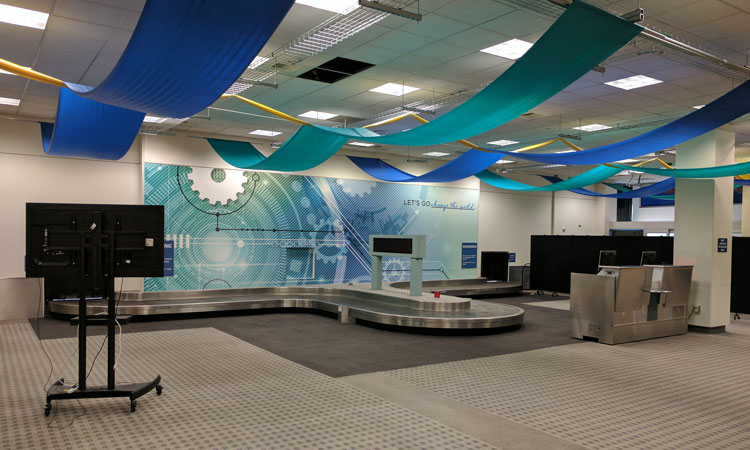

The Innovation Lab space ready for use
Engaging innovators in this space offers them a huge opportunity. The barriers to entry for doing business in airports are daunting and so our lab was designed to allow innovators to gain experience needed to access the aviation industry and succeed.
As we fleshed out the best way to foster innovation, we worked with FuelRod, a reusable, portable charging product available in vending machines. Enabling them to fine-tune the concept in our space provided real proof-of-concept for the lab itself. We focused on four pillars to inform our quest:
- Enhancing the passenger experience
- Improving operational efficiency
- Increasing revenues
- Decreasing operating costs.
Innovations that promised more than one of these would be truly intriguing.
Our original thinking was that successful innovators could negotiate a contract with SAN and/or other airports. Our thinking evolved to foresee possibilities of working with ‘analogous venues’ such as shopping malls, convention centres, other transportation hubs and even major sports facilities.
The discovered innovations so far
The first innovator formally welcomed into the Lab was AtYourGate, a service that uses a mobile app to let customers order food or retail items from airport concessionaires to be delivered to their gates. This allows them to save valuable time, choose from the airport’s many offerings, and not risk losing their hold room seat or missing a boarding call.
Now, AtYourGate is available in nine airports and is our first end-to-end success story.
To cast a wider net for innovators and ideas, as well as to efficiently and effectively manage the lab, and ‘accelerate the accelerator programme’, we sought out a third-party operator. After an extensive RFP process, we contracted with Detecon Innovation Institute (DII), part of the management consulting practice of Deutsche Telekom, in January 2018.
Innovators batch one
Our concept was taking shape and with DII’s help, we crafted a 16-week accelerator programme and solicited innovators from around the world. The first batch of innovators began in August 2018 to test concepts in two areas – airport parking and helping passengers with unique needs navigate the airport environment.
One of the innovators in that batch was Baggage Nanny, which offers baggage pick-up, storage and delivery between the airport and lodging, or during flight delays or layovers. The service gives passengers the ability to take full advantage of their time in San Diego – or elsewhere – without lugging baggage with them. Baggage Nanny is now in operation at SAN and in discussions with two other airports.
Innovators batch two
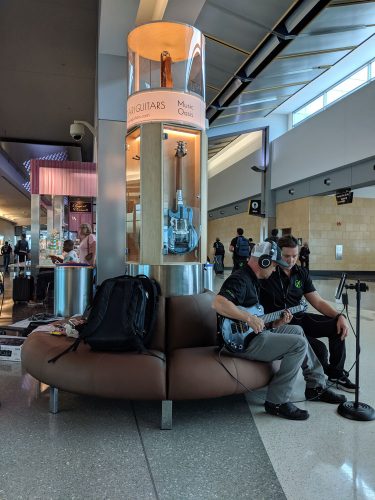

The guitar kiosk trial
For our second batch, we took a very different approach, posting an ‘opportunity statement’ that did not focus on any specific airport function. We referred to it as a ‘wild-card’ opportunity to come in and show us what we had not thought of before.
The wild-card approach surfaced a wide range of ideas and we welcomed the second batch into the lab in April 2019. The concepts ranged from a guitar kiosk featuring the world’s first full-size, foldable travel guitar, to autonomous robots to guide passengers, to a vehicle-to-grid application that lets travellers with excess electric vehicle battery energy sell it back to the grid or to the airport’s buildings.
Innovators batch three
Currently we have brought our third batch into the lab (in August 2019). This time, we posted two opportunity statements, one focused on interactive children’s entertainment and one wild card. The concepts this time include mobile, deconstructable play carts for children, flexible and programmable LED belts for way-finding, and virtual and augmented reality targeting teens and pre-teens.
What innovation is next and where is this going?
When we are asked what the future will contain, we are excited to say that, to some extent, we don’t know. In a sense, the entire lab focus is a wild card, seeking to solve challenges we know we have with solutions we don’t have; allowing for solutions to things we didn’t target. But we do see the next few steps and are pleased to share some of the first lessons learned.
For our fourth batch, which we will start recruiting before the end of 2019, we are focused on airport functions. Our staff asked different departments to tell us specific needs that have budgets behind them to implement successful solutions. For example, we see potential for our Environmental and Facilities departments, among others.
As we look ahead to our fifth batch late summer in 2020, we hope to help develop more innovations and modify the procurement process to speed up deployment at SAN.
The big lesson learned
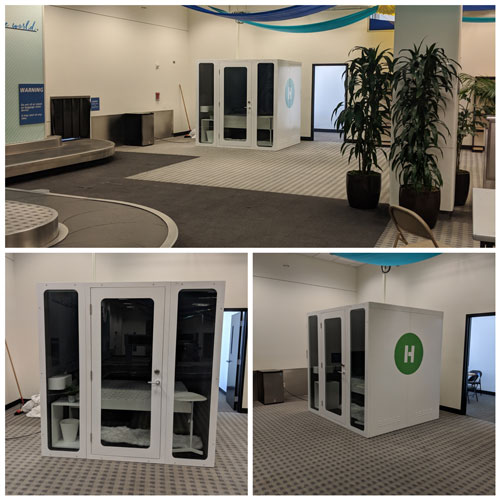

A sleep pod was another innovation explored at the lab
We had thought it might take two to three years to go from proven concept to deployment if the innovator successfully negotiated a contract. As it turns out, the cycle is closer to one year. As we focus on specific department needs, and potentially modify the procurement process, that time could decrease further.
Another big lesson learned in terms of the passenger experience is how to define the true sweet spot. In brief, it means innovations that target areas with low (pre-existing) satisfaction levels with the potential for high impact. Examples include enhancing convenience, way-finding, mobility and entertainment; or reducing confusion and stress. Think AI robots, for one.
We also learned how other airports are watching our Airport Innovation Lab. We thought they might target our successful innovators right out of the chute, but most want to see how they deploy at SAN first. While we have the four focus areas listed in the beginning, most airports home in on increasing revenues and decreasing costs.
The last big lesson learned is that success depends on support from above. SAN is thankful to the Airport Authority Board, as well as President/CEO Kim Becker, the solid partnerships with other organisations (like Detecon Innovation Institute), and the skilled, passionate staff at the airport. With all of those, the sky’s the limit!
Biography
Rick Belliotti is San Diego County Regional Airport Authority’s Director, Customer Experience and Innovation. He has been with the Airport Authority for six and one-half years.
Belliotti is an experienced senior manager and entrepreneur who has worked in companies of all sizes.
He has been very active in the aviation industry with IATA and ACI, and served on several management groups and committees for these organisations, participating in the creation of industry standards and policies including CUPPS (Common Use Passenger Processing Systems) and CUSS (Common Use Self Service).
Related topics
Augmented reality (AR)/ Virtual reality (VR), Information technology (IT), New technologies



